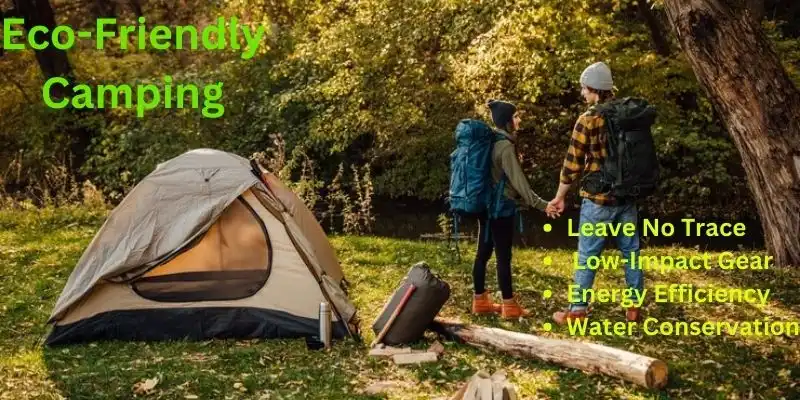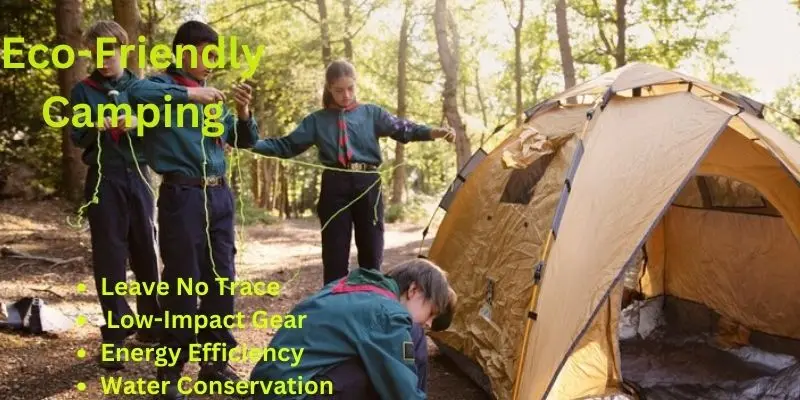4 Eco-Friendly Camping Tips for Green Adventurers: Powering Up Your Outdoor Experience
Updated: 18 Mar 2024
219
Going camping lets us get close to nature and take a break from busy daily life. But when we go out into nature, it’s important to think about how we impact the environment. For people who care about the Earth, love nature, and want to camp in a way that’s good for the planet, it’s not just a choice—it’s something we should do. This guide gives easy tips and shows good examples to help you have fun in nature while also taking care of it.
Features of Eco-Friendly Camping
Eco-friendly camping involves practices that minimize harm to the environment and promote sustainability. Some features of eco-friendly camping include:
1. Leave No Trace
Practicing Leave No Trace principles by packing out all trash, minimizing campsite impact, and respecting wildlife habitats.
2. Low-Impact Gear
Choosing camping gear made from sustainable materials, such as recycled or biodegradable materials, and opting for durable, long-lasting products to reduce waste.

3. Energy Efficiency
Using renewable energy sources like solar power for lighting and charging devices, and minimizing energy consumption by using efficient appliances.
4. Water Conservation
Practicing water-saving techniques like using biodegradable soap, limiting water usage for washing dishes and bathing, and properly disposing of wastewater.
5. Sustainable Food Practices
Opt for locally sourced, organic, and minimally packaged food items, and avoid single-use plastics using reusable containers and utensils.
6. Respect for Nature
Respect wildlife and natural habitats by observing wildlife from a distance, staying on designated trails, and avoiding damaging plants and trees.
7. Education and Advocacy
Learning about environmental issues and sharing knowledge with fellow campers to promote awareness and inspire others to adopt eco-friendly camping practices.
Leave No Trace
The Leave No Trace principles are a foundational guideline for eco-friendly camping. Adhering to these principles ensures that you minimize your impact on the natural areas you visit.
Principles of Leave No Trace
| Principles |
|---|
|
Pack it in, pack it out
Make sure to bring all your garbage back with you. If you bring it in, it’s your responsibility to take it out.
Respect wildlife and nature
Maintain a safe distance from animals and do not feed them, as this can alter natural behavior and endanger both wildlife and humans.
Sustainable Gear
Choosing sustainable gear is not just about buying products labeled as ‘eco-friendly.’ It’s about considering the entire lifecycle – from production to disposal.
Examples of eco-friendly gear options
- Non-toxic, biodegradable soaps and toiletries
- Solar-powered chargers and lights
- Recycled and recyclable camping equipment
Tips for choosing sustainable gear
- Research brands committed to sustainability like Patagonia.
- Opt for products made from natural or recycled materials.
- Seek out gear that is durable and repairable, reducing the need for frequent replacements.

Eco-Friendly Practices
Incorporate environmental consciousness into every aspect of your camping adventure—from conserving energy to managing waste sustainably.
Energy conservation tips
- Use natural light as often as possible.
- Opt for renewable energy sources, such as solar panels.
Water conservation techniques
- Collect and use rainwater for non-drinking purposes.
- Use water-saving devices like a solar shower.
Sustainable cooking and waste management
- Plan meals that require minimal packaging.
- Compost organic waste when possible and avoid single-use plastics.
Pros and Cons of Eco-Friendly Camping
While eco-friendly camping has many benefits, it also comes with its own set of pros and cons. It’s essential to weigh both sides before starting on your next green adventure.
| Pros |
|---|
|
| Cons |
|---|
|
Case Studies
1. Patagonia Provisions’ “Food for Camping” line
This initiative focuses on providing organic, sustainable food options specifically designed for campers. They offer products that are sourced with a commitment to environmental stewardship and agricultural regeneration.
2. REI’s sustainable gear initiative
REI offers an array of eco-friendly products. Its commitment extends to ensuring the sustainability of its in-house gear, while also supporting environmental causes through various initiatives.
3. Yosemite National Park’s “Leave No Trace” campaign
Yosemite is an illustrative case of successful eco-friendly practices. Their comprehensive “Leave No Trace” campaign educates visitors on how to minimize their impact, significantly reducing waste and preserving park ecosystems.
Conclusion
The next time you head out into the wilderness, remember that eco-friendly camping does not only enhance your outdoor experience but safeguards the natural beauty that draws us to camp in the first place. By adopting green practices, respecting nature’s fragility, and opting for sustainable gear, we can all contribute to preserving these wondrous environments for generations to come.
Remember to take only memories and leave only footprints as you implement eco-friendly camping, sustainable gear, and Leave No Trace principles into your adventures. Together, we can sustain the great outdoors for everyone to enjoy.
FAQs
What is eco-friendly camping?
Eco-friendly camping, also known as green camping or sustainable camping, refers to a camping practice that minimizes negative environmental impacts, conserves resources, and promotes biodiversity.
Why is eco-friendly camping important?
Eco-friendly camping is important because it helps preserve natural landscapes, reduces pollution, conserves energy and water resources, and protects wildlife habitats for future generations to enjoy.
What are some eco-friendly camping practices?
Some eco-friendly camping practices include using biodegradable or reusable camping gear, minimizing waste by packing out trash, using eco-friendly toiletries, respecting wildlife and natural habitats, and choosing low-impact campsites.
What is sustainable gear?
Sustainable gear refers to camping equipment and supplies that are designed and manufactured with environmentally friendly materials and production methods, minimizing their ecological footprint.
How can I find sustainable camping gear?
You can find sustainable camping gear by looking for products made from recycled materials, organic fabrics, or renewable resources. Additionally, choosing gear from companies with transparent sustainability practices and certifications can help ensure you’re making an environmentally friendly choice.
What is the Leave No Trace principle?
The Leave No Trace principle is a set of outdoor ethics promoting responsible recreation to minimize human impact on natural environments. It encourages campers to leave campsites in the same or better condition than they found them.
Why is Leave No Trace important?
Leave No Trace is important because it helps preserve the integrity of natural areas, prevents damage to ecosystems, and ensures that future generations can continue to enjoy outdoor recreational activities in pristine environments.
Please Write Your Comments